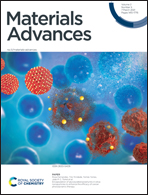Intensifying sustainable solar water production by steam heat internal circulation†
Abstract
Solar interfacial evaporation, as a green technology, is currently one of the feasible means for producing potable water for practical applications. However, the sustainable development of this technology faces great challenges due to the low conversion efficiency of solar to steam energy and, especially, the limited capabilities for the storage and reuse of steam energy. Herein, a simple steam heat internal circulation system was designed for integrated steam condensation, heat storage, and circulation, to achieve maximum solar energy utilization. Low-cost, easy-to-prepare, non-polluting carbon-black-loaded glass fiber cotton (CBGF) was selected as an interfacial evaporator, which can enable continuous evaporation for 42 h in highly concentrated brine (20 wt%) with excellent photothermal stability and near 100% ion rejection. In the simple system, the steam energy is stored as electricity by thermoelectric (TE) devices, and it can be further used to enhance water evaporation. In such a circulating system, the water production rates can increase 1.32- and 1.44-fold compared with those of a system without TE devices under 1 and 2 sun illumination, respectively. The steam heat internal circulation achieves enhanced water yields and shows great potential to deal with freshwater shortages.



 Please wait while we load your content...
Please wait while we load your content...